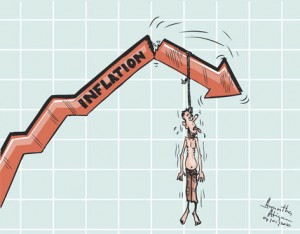Despite the fact that section prices tripled in fifteen years to 2007, land is not now included in the Consumer Price Index. This means that the official measure of inflation is unreliable as it is far lower than the actual figure.
Today I received a letter back from the Minister of Statistics, Hon Maurice Williamson. I had heard that land went out of the CPI but couldn’t remember when or why so I sent in an Official Information request. The Minister dates the letter 14 Mar 2012 and says “Dear Ms Kent
Thank you for your letter of 20 February regarding the exclusion of the price of land from the Consumers Price Index (CPI) basket of goods.
“I am advised by Statistics New Zealand that land (i.e. residential section) was included in the CPI until the June 1999 quarter. Following a review of the CPI in 1997 land was excluded, taking effect from the September 1999 quarter.
“The 1997 review by an external advisory committee confirmed the CPI’s main purpose as being informing monetary policy setting, and that the CPI should be focussed on the concept of “acquisition”. The reason given for excluding land from the CPI from 1999 was that it was considered to represent the investment component of home ownership (with dwellings representing the shelter component).
“The September 1999 quarter CPI information release explained it as follows: “A dwelling provides shelter over a long period of time. Over time land is not consumed and so can be considered to represent the investment component of home ownership. As investment expenses are outside the scope of the CPI the rebased CPI excludes expenditure on residential sections.”
“Information on the sale of land is available from QV (www.qv.co.nz) and the Real Estate Insititute of New Zealand (www.reinz.co.nz).
I trust this information meets your needs and thank you again for taking the time to write.
Yours sincerely
Hon Maurice Williamson
Minister of Statistics.
 You can be assured I will write back to ask how inflation can be accurately measured when the price of residential sections is excluded. Every time a section rises in price it puts up the price of the property. So when someone buys property in the future, they will have to pay a higher prices than previous owners paid. This also means the total mortgages and the total money supply has to rise accordingly. When the money supply increases there is inflation. So it is not a small quantity we are talking about. We are neglecting a huge factor. The CPI cannot be taken as a valid measure of inflation and there is no reason to have any faith in it. The Productivity Commission said the price of residential sections tripled in the fifteen years to 2007.
You can be assured I will write back to ask how inflation can be accurately measured when the price of residential sections is excluded. Every time a section rises in price it puts up the price of the property. So when someone buys property in the future, they will have to pay a higher prices than previous owners paid. This also means the total mortgages and the total money supply has to rise accordingly. When the money supply increases there is inflation. So it is not a small quantity we are talking about. We are neglecting a huge factor. The CPI cannot be taken as a valid measure of inflation and there is no reason to have any faith in it. The Productivity Commission said the price of residential sections tripled in the fifteen years to 2007.
 Right now we are going through a period of fairly stable prices, but no doubt in the future the cycle will come around again and prices will rise. The value of all residential properties in New Zealand was estimated by the Tax Review committee of 2007 to be $298 billion. This excluded land for commercial forestry, agriculture, industrial, commercial or mining or land owned by central or local government.
Right now we are going through a period of fairly stable prices, but no doubt in the future the cycle will come around again and prices will rise. The value of all residential properties in New Zealand was estimated by the Tax Review committee of 2007 to be $298 billion. This excluded land for commercial forestry, agriculture, industrial, commercial or mining or land owned by central or local government.
As Eisenstein says “Money is deeply and irretrievably implicated in the conversion of the land commons into private property, the final and defining stage of which is its reduction to the status of just another commodity that can be bought and sold.” After this letter, we could add to this “and used as an investment”.
